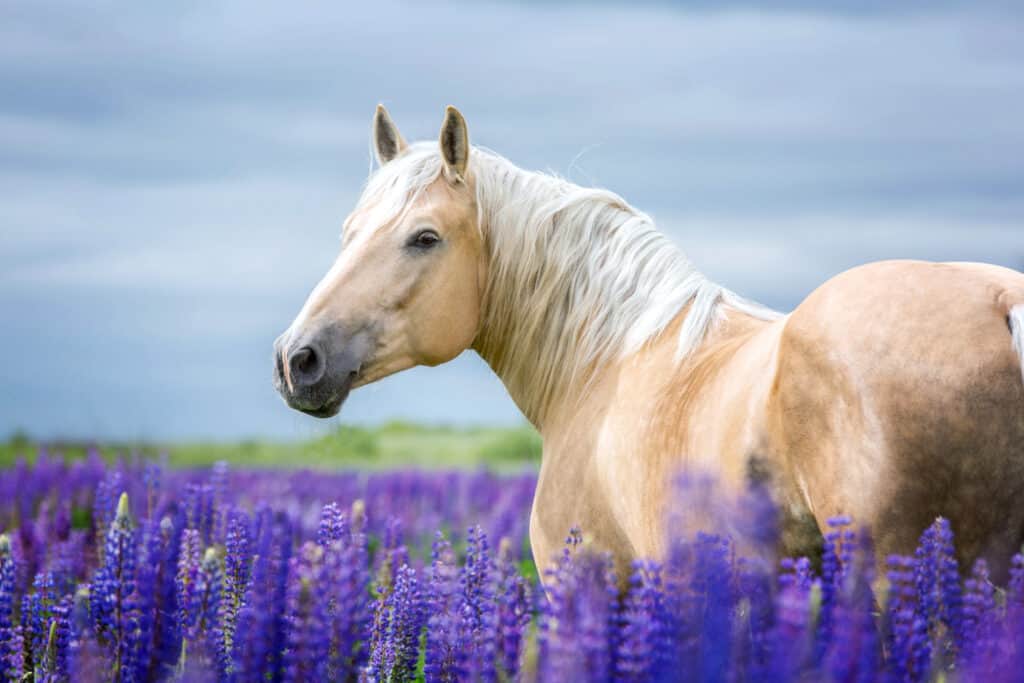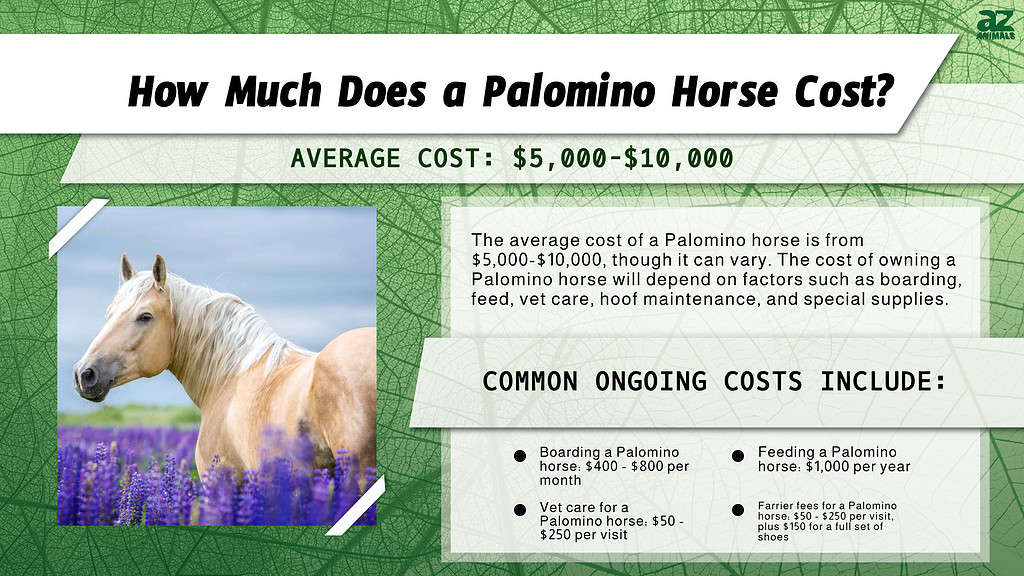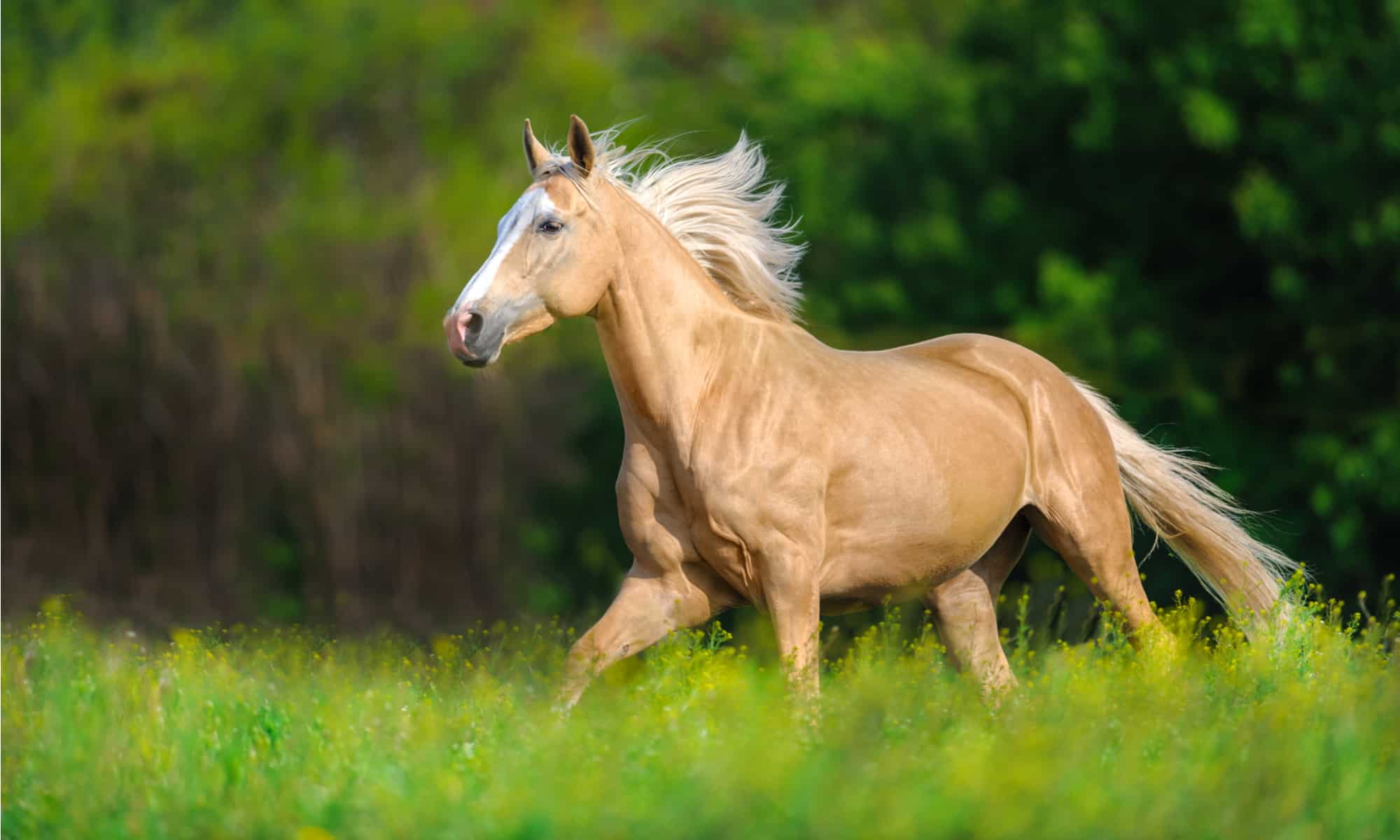You want to learn more about the cost of buying a Palomino horse as well as the monthly expenses for their ongoing care. Well, the price of a Palomino horse in 2024 depends on their breed, age, and level of training. As for maintenance costs, the quality of feed, what equipment you buy, and the level of care you provide will affect how much you spend monthly.
But before we get too deep into the logistics of owning a horse, let’s learn more about the pretty Palomino horse.
Is Palomino a Breed or a Coloring?

Every Palomino has white or cream-colored manes and tails.
©Osetrik/Shutterstock.com
It might surprise you to know that “Palomino” refers to a color rather than a breed of horse!
Palomino describes a gold-colored horse, with shades varying from light to dark. Their skin is either black, gray, brown, or varied, with characteristically pink spots on their face or legs. They also always have white or cream-colored manes and tails. While you don’t frequently see Palomino horses with blue eyes, it is possible.
What Breed Are Most Palominos?
Almost any breed of horse can be Palomino. That’s why you can find Palomino horses competing at rodeos, working on ranches, and even running in races.
However, according to the Palomino Horse Breeders of America (PHBA), “though many types of horses may bear the gold coloring, the PHBA represents only Quarter Horses, Tennessee Walking Horses, Morgans, Arabians, and American Saddlebreds” in their registry.
Plus, some common breeds never showcase the Palomino coloring because of their genetics:
- Przewalski’s horses (only dun with a black dorsal stripe down their backs)
- Haflinger’s (only chestnut with flaxen or white manes and tails)
- Black Forest horses (only chestnut with flaxen manes and tails)
- Lipizzaner’s (only white)
- Friesian horses (only black)
The Average Lifespan of a Palomino Horse
Since Palomino is a color and not a breed, the average lifespan of a Palomino is like that of any other horse breed — between 20-25 years. However, some horses can live to be up to 35 years old!
How Rare Are Palomino Horses?

Palomino horses can range from a light cream, almost white to a deep golden color.
©PardoY/Shutterstock.com
Because their physical characteristics have to fit into certain parameters to be considered “Palomino” — their mane and tail must be white with no more than 15% dark, sorrel, or chestnut hairs — this horse coloring is rarer than others like bay or chestnut.
All-in-all, Palomino is a fairly common horse coloring, which means Palomino horses are not rare.
Where to Find Palomino Horses for Sale

There are many different places where you can find a Palomino horse for sale in your price range such as:
- In online classifieds
- At a horse auction
- Through a reputable trainer or breeder
- From a horse rescue
The average price for a Palomino horse in 2024 is between $5,000-$10,000. Palomino horses for sale under $1,000 will likely be green, young, or come with behavioral/health issues. If you’re buying from a private owner, ask for the horse’s pedigree and history before you hand over any cash.
Palomino Horse Prices in 2024: How Much Do Horses Cost to Own
Palomino horses come in many breeds, sizes, and experience levels. This means that the purchase price of a Palomino horse in 2024 can range from under $1,000 to upper 5-figures. But that’s not the only cost to consider — the cost of owning and caring for a horse can add up over the years!
Let’s learn more about how much Palomino horses cost, broken down by the price of boarding, feed, vet care, hoof maintenance, showing, and supplies.
How Much Is It Per Month to Board a Palomino Horse?
Boarding a Palomino horse can be more expensive than boarding a bay or chestnut. Why? Because any areas of white or pink skin are more sensitive to sunlight.
Since Palominos have characteristically white faces and legs, this means that they require special considerations — like stall boarding to keep them out of the sun and full-service care to apply sunblock or a mask to sensitive areas when you’re not around to do it yourself.
So how much do Palomino horses cost to board?
Stall boarding is more expensive than field/paddock boarding (around $800 and $400, respectively), but it may end up costing you less in the long run if you own a Palomino. Since Palomino horses have pink noses and a light-colored undercoat, keeping them out of the sun will decrease their risk of sunburn and skin cancer, saving you money on future vet bills.

Horses with pink noses, like Palominos, are more prone to health issues like sunburn and skin cancer.
©Zbynek Pospisil/iStock via Getty Images
How Much Does It Cost to Feed a Palomino Horse?
The average cost to feed a Palomino horse is around $1,000 a year. This will depend on your location, the cost, and quality of feed, and whether your horse free-grazes on grass and hay or eats grain.
What’s the Cost of Vet Care for a Palomino Horse?
Palomino horses require the same level of care as other horses, just with a few special considerations. You can expect to pay between $50-$250 per routine vet visit, not including any medications, supplements, or treatments given.
You also have to consider the cost of daily sun protection and potential cancer treatments when deciding whether to buy a Palomino horse. Due to the pink skin on their faces and legs as well as their light-colored undercoat, they are more prone to sunburn and skin cancer.
Despite their sensitivity to sunlight, there are no color-specific health issues associated with Palomino horses. Vet costs will depend more on your Palomino horse’s breed than its coloring.
What Farrier Fees Come With Owning a Palomino Horse?
As with any horse, Palominos will need routine hoof care every 4-6 weeks. The price for a farrier to do a trim can range from $50-$250 per visit. If your horse needs shoes, that will cost you an additional $150 for a full set.
What Is the Cost to Compete at a Show With a Palomino Horse?
Palomino horses can be a variety of different breeds, which means you will see Palominos competing in events across all disciplines — from barrel racing and carriage driving to dressage and eventing.
The cost to show with a Palomino horse will vary widely depending on the equipment and clothes required as well as the entry fee(s) for the specific competition you decide to enter.
Do Palomino Horses Require Special Supplies?
Yes, Palomino horses require special supplies! This is because Palomino horses’ coloring puts them more at risk for health problems like sunburn and skin cancer.
While it may be optional for horses of a different color, there are certain supplies necessary year-round for Parlominos to look and feel their best:
- Sunblock for their sensitive skin to prevent sunburn
- Purple shampoo to keep their white manes and tails clean
- A UV-blocking face mask to protect against skin cancer
- Shelter from the sun as much as possible
The Price of Palomino Horses in 2024

Palomino horses are a unique addition to any barn.
©Pictureguy/Shutterstock.com
As you can see, Palomino horses are pretty animals that require more protection and upkeep than others due to their unique coloring. So when you consider the price of buying a Palomino horse in 2024, just make sure you also factor in all of the ongoing costs associated with them.
Thank you for reading! Have some feedback for us? Contact the AZ Animals editorial team.








